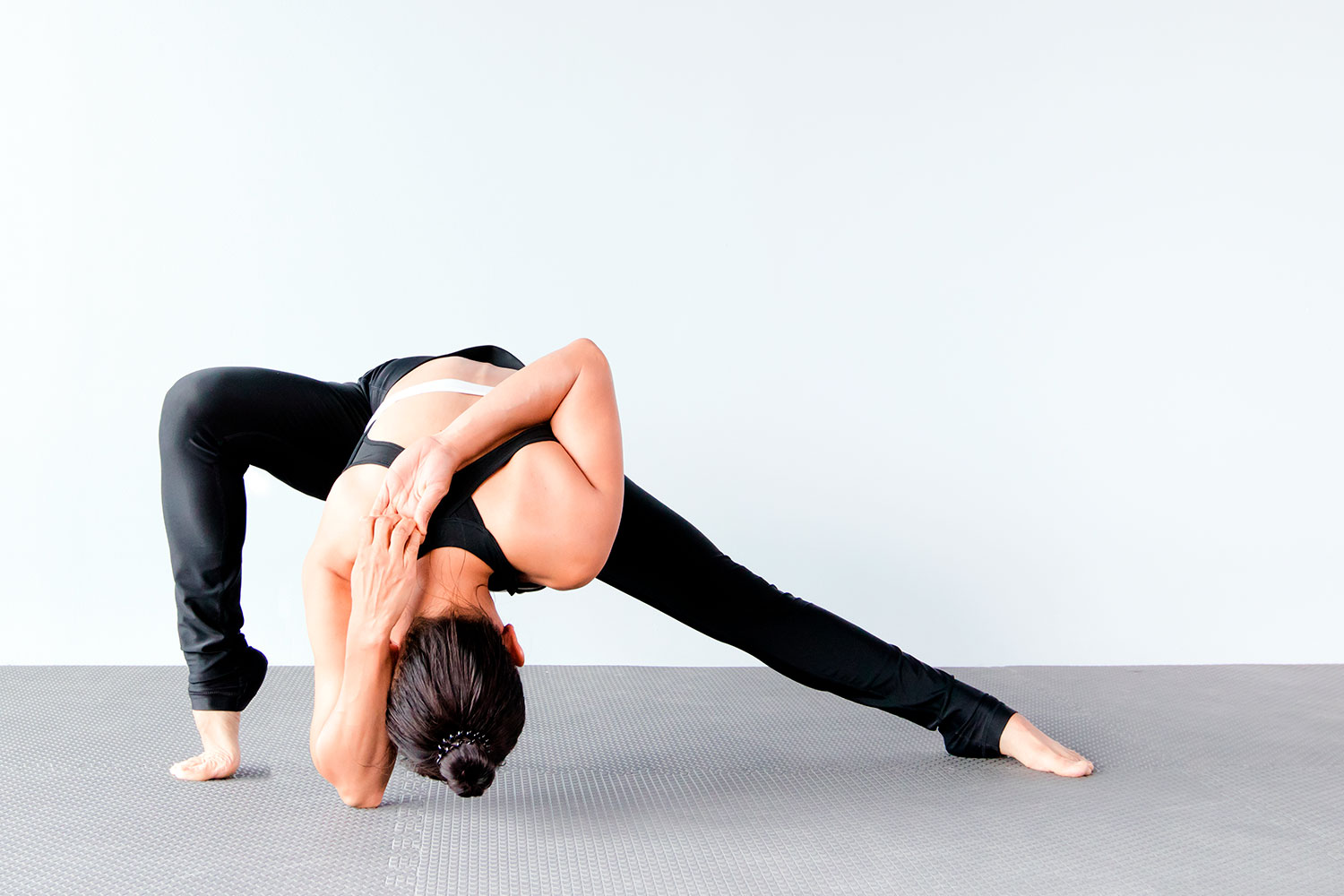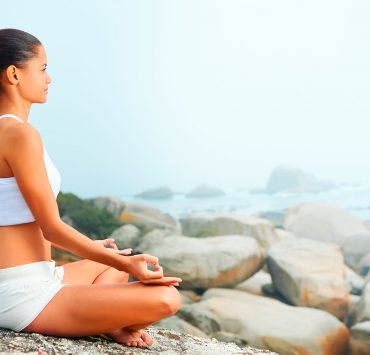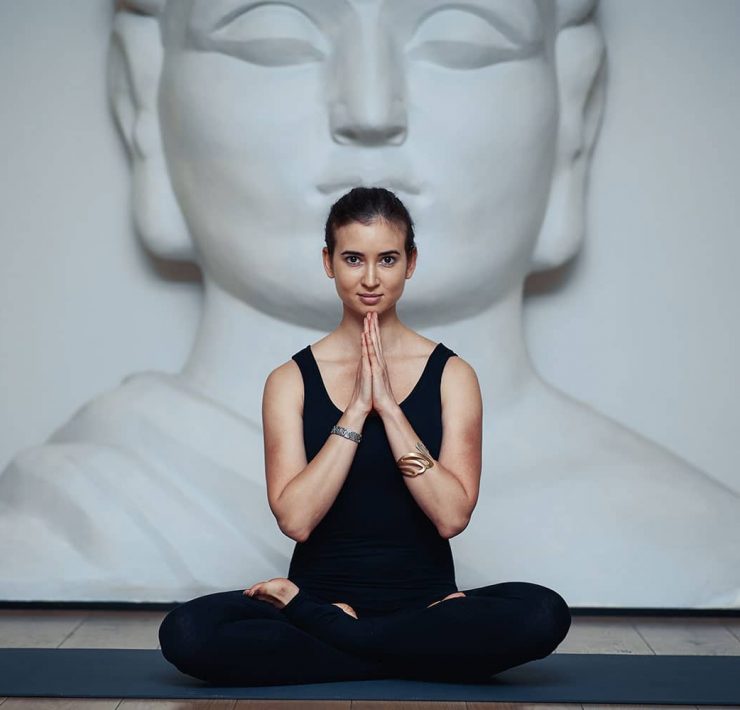
Rose graduated with a degree in Anthropology, which takes her…
Beginning a yoga practice can be an intimidating experience, and not just because of all the advanced poses. Some students may be surprised to show up to their first class and find the teacher speaking a completely different language! Many yoga teachers use Sanskrit intermixed with English as they teach. Using Sanskrit is partly an homage to the history of yoga, and partly a way to unite students from various cultural backgrounds. Although the Sanskrit may seem unnecessary to start with, yogis soon learn to appreciate how it creates a common language for yoga.
History Of Yoga Language: Sanskrit
Sanskrit is the original language of yoga. The roots of yoga can be traced back to India 5,000 years ago. The first written accounts of yoga are in the Upanishads, followed by the Bhagavad Ghita, both written in Sanskrit. The same is true of the Yoga Sutras of Patanjali, an essential text in classical yoga.
When modern yoga teachers speak in Sanskrit they call to mind these thousands of years of history. Although it is certainly confusing for new yoga practitioners, they should know that using Sanskrit is a sign of authenticity and respect toward the true history of yoga.
How To Understand Sanskrit If You Don’t Speak It

Sanskrit is, technically, a dead language. However, there is controversy over this because unlike other dead languages, it lives on in those who study and practice yoga. But how can people understand and use Sanskrit if it’s a dead language? It’s true that Sanskrit is a very complex language to learn and uses Devanagari, its own alphabet. Nevertheless, there are ways to understand Sanskrit words and phrases even if you are not fluent in it. This starts with knowing the structure of Sanskrit, so that phrases can be pieced together. Essentially, the yogi can benefit from learning the smaller vocabulary pieces of Sanskrit, and use logic to combine them.
One example is the pose called ‘eka pada rajakapotasana.’ In Sanskrit, this lengthy name is a mouthful. However, consider the English version of this pose: ‘one legged king pigeon pose.’ If the yogi knows small pieces of Sanskrit, for example ‘eka’ (one), ‘pada’ (leg/foot), ‘raja’ (king), ‘kapota’ (pigeon), and ‘asana’ (pose), they can better translate the Sanskrit of this pose, and vice versa.
Why Do Yoga Teachers Still Use Sanskrit?
By understanding both the history of Sanskrit’s contribution to yoga, and the basic structure of the Sanskrit language, new yoga students can significantly ease their confusion. It is important to understand that yoga teachers don’t speak in Sanskrit to be mystical or obtuse. Instead, their use of Sanskrit is a way to honor the traditions of the practice, respect its history, and promote a sense of universal language and union. Union, after all, is the meaning of yoga in Sanskrit.
Before overwhelming yourself with the history, structure, and phonetics of Sanskrit, it may help to learn some basic words. There are many Sanskrit words that yoga teachers use over and over again throughout a class. Below are 15 of the most commonly used Sanskrit words that any new student should learn to be less confused in yoga class.
Asana

Asana is perhaps the most commonly used and therefore most important word to learn, so as to be less confused in yoga class. As it is understood today, ‘asana’ refers to yoga poses. This is why all yoga pose titles end with the suffix ‘asana.’ For example, there are ‘virabhadrasana,’ ‘uttanasana,’ ‘paschimottanasana,’ and countless more.
However, there is more to the word ‘asana’ than this. In yoga’s origin in the Vedas, asana was not used. Instead, the word ‘as’ was used to mean ‘to sit.’ It was only in later texts such as the Upanishads and the Yoga Sutras of Patanjali that the word ‘asana’ was used to imply moving postures. As different schools of yoga developed, the current understanding of yoga poses was developed. However, moving asana has the goal to make the body fit for seated meditation, or sitting. In this way, it still has its roots in its original translation ‘to sit.’
Ujjayi

You may hear your yoga teacher refer to ‘ujjayi breath.’ What does this mean and how is it different from other kinds of breathing? To understand Ujjayi, you must first understand that there is an entire limb of yoga dedicated to breathing techniques. Yogis believe that by controlling the breath, the mind, body, and spirit can also be controlled and healed. Various breathing techniques have different benefits and effects on the body. The breathing technique that is most commonly used during general yoga practice (during asanas) is Ujjayi breathing.
Ujjayi itself directly translates to ‘victorious.’ By using the ujjayi breathing technique, the yogi can experience feelings of transcendence and victory. To practice ujjayi breath, breathe evenly through the nose. Slightly constrict the glottis at the back of the throat so that each exhale comes out as a soft ‘ha’ sound. In most classes, this breathing is maintained and matched with each asana.
Prana

Yoga teachers may say things like ‘feel the prana extending through your fingertips.’ How do you engage or feel something that you don’t even know the definition of?
Prana is one of the yoga concepts that must be felt to be understood. From Sanskrit, it translates to ‘energy’ or ‘life.’ All living beings have prana, but when prana becomes stuck or stagnant, illnesses and pain can occur. In yoga, prana is important because it is believed to flow through meridians in the body, known as ‘nadis.’ When practicing poses, ‘prana’ refers to consciously extending energy through these nadis. For example, when you reach your arms up in a pose, don’t let your fingers hang limply. Instead, push prana through your fingertips and feel them extend and engage, brightening both the pose and your own energy.
Drishti

‘Drishti’ is a Sanskrit word that means ‘sight’ or ‘gaze.’ When a yoga teacher uses the word drishti, they are not referred to the third eye or metaphorical sight. They are referring to your literal, physical gaze. Drishti, or gaze placement, is meant to enhance concentration and meditation experience in yoga poses, by supplying a sense of focus. There are nine different types of drishti, and various ways to practice it. However, when you are just beginning a yoga practice you should listen to your teacher and try simple drishtis. For example, in balancing poses choose one place to gaze. In forward folds bring your drishti toward your nose, or toes.
Chakra

When a yoga teacher uses the word ‘chakra,’ it can seem like a very metaphysical and mysterious concept. In Sanskrit, the word translates to ‘wheel’ or ‘disc.’ But what exactly are chakras? Chakras are said to be seven energy centers along the center line of the body. Each chakra is aligned with an intersection of energetic meridians, and biologically they are located at the same place as lymph nodes. Chakras are still not fully understood, yet there has been quantum physics research to further understand them.
In yoga, each chakra has a different energetic presence, color, and effect. For instance, the muladhara chakra (root chakra) is located in the perineum and is the center of emotional and physical grounding. Standing and balancing poses can help activate the root chakra. Each person will have a dynamic and unique combination of openness or stuck-ness in their chakras, based on personal experience. Yoga poses can be used to target specific chakras.
Adho Mukha Svanasana

Many yoga teachers use Sanskrit not just to define yogic concepts, but also for the individual poses. It is common practice for many Western yoga teachers to say a pose in English and Sanskrit, although sometimes they will just speak in Sanskrit! Adho Mukha Svansana is one of the most commonly heard Sanskrit phrases in yoga class because it refers to one of the most commonly practiced poses – downward facing dog! In Adho Mukha Svanasana, the yogi has both hands and feet planted on the mat, and presses back to reach the sit bones upward.
Namaste

The word ‘namaste’ is associated with yoga in popular culture, and is often used as a group chant at the end of class. But what does Namaste actually mean? In Sanskrit, ‘namaste’ translates to ‘bowing to you.’ It is commonly combined with a physical bow, as it is during the end of a yoga class. However, in Indian culture, saying Namaste is also a way of greeting someone with an element of respect. When saying Namaste, either as a greeting or as a farewell, place the hands together in a prayer position and bow the head. This is perhaps the simplest way to incorporate Sanskrit into a yoga class and retain the sense of respect for yoga’s Sanskrit history.
Vinyasa

One of the most confusing situations for a new yogi might be when a teacher says to ‘take a vinyasa.’ A what? A ‘vinyasa’ refers to both a physical sequence of poses, and an entire style of yoga. Within a yoga class, a yoga teacher will use the word ‘vinyasa’ to refer to the sequence of plank to chatturanga to upward facing dog, and back to downward facing dog. A vinyasa sequence is a short but physically demanding sequence that is used between the sun salutations, and between different yoga sequences chosen by the teacher. When used to refer to a style of yoga, ‘vinyasa’ describes the flowing, active style of yoga that often incorporates the short vinyasa sequence between poses. In terms of Sanskrit, the word ‘vinyasa’ is actually a derivative of the word ‘nyasa’ which means ‘to place.’
Utkatasana

Utkatasana is another yoga pose that is commonly taught in classes. This is because it is part of the second sun salutation sequence which is incorporated in many yoga classes. In English, Uttkatasana is called ‘chair pose.’ In this pose, the yogi stands up straight with the arms reaching overhead, and bends the knees, as if they were going to sit back in a chair. This pose can be part of a fast moving sun salutation, or it might be held for longer periods during hatha or Iyengar yoga, so as to activate prana within the body.
Savasana

Savasana has a morbid translation and that is one reason yoga teachers often just used the Sanskrit instead of the English translation. From Sanskrit, ‘savasana’ is derived from two words: ‘sava’ and ‘asana.’ ‘Sava’ means corpse, and ‘asana’ as discussed, means posed. Together, ‘savasana’ means corpse pose. Despite the English translation bringing to mind a corpse, Savasana is one of the most loved (and most challenging) yoga poses. It is practiced by lying on the back at the end of yoga practice. It can be held for a few minutes or even longer, as the yogi silently meditates and soaks up their entire practice. The translation into corpse is really not meant to be morbid, but rather refers to the death, or ending, of a yoga practice. However, what comes with this death is also rebirth as the yogi enters the rest of their day renewed and refreshed from yoga.
Bandha

‘Bandha’ is another Sanskrit word. It means ‘tightening’ or ‘locking.’ This refers to both a muscular and an energetic tightening deep within the body. Yogis believe that there are multiple Bandha points throughout the body where interior muscles connect. These are:
- Mula bandha
- Uddiyana bandha
- Jaladhara bandha
- Maha bandha
Each bandha has a different anatomical location. Different yoga poses may require engaging different bandhas. Bandhas can specifically help with inversion poses such as headstand or handstand. Without engaging the bandhas, the yogi will not get the lift or float they require to invert.
Tadasana

Tadasana is another yoga pose. It is formed by two Sanskrit words. ‘Tada’ means mountain, and ‘asana’ means pose. In English, Tadasana is usually taught as ‘mountain pose.’ In Tadasana, the yogi stands at the top of their mat with feet planted firmly into the ground. The arms are down by the sides with palms facing forward. Prana, or energy, is felt through all limbs.
Utthita

A yoga teacher may use the phrase ‘utthita’ within multiple contexts. They may also combine the word ‘utthita’ with the names of yoga poses. This is one situation in which knowledge of Sanskrit structure, or smaller pieces of Sanskrit vocabulary such as ‘utthita,’ can help clarify the meaning of longer Sanskrit phrases. Utthita translates to ‘extend.’ For example, if a yoga teacher says to practice ‘utthita virabhadrasana,’ they mean to practice the virabhadrasana pose (warrior pose), with the arms extended. ‘Utthita’ is usually used to modify standing poses by extending either an arm or a leg.
Hasta

‘Hasta’ is another Sanskrit word, like ‘utthita,’ that is not used very often on its own, but is very useful to know in combination with other Sanskrit phrases used in a yoga class. In English, ‘hasta’ means ‘hand.’ When you hear the word ‘hasta’ in the title of a yoga pose, it means that the hands will be involved somehow. Examples include ‘utthita hasta padanghustasana’ in which the hand is extended toward the foot (‘pada’), or ‘baddha hasta’ meaning bound hands.
Baddha

The word ‘baddha’ is Sanskrit for ‘bind.’ It can be remembered because it is similar to the word ‘bandha’ which means ‘lock’ or ‘tightening.’ Whereas a bandha is an internal locking, a baddha is external. Yoga teachers will say ‘baddha’ to refer to, typically, a hand bind in a yoga posture. For instance, in warrior pose a bind can be found by reaching the arm underneath the front thigh and finding a clasp with the back arm. Another common pose is ‘baddha konasana’ which translates to English as ‘bound angle pose,’ where the yogi sits with the soles of the feet bound together.
Conclusion
Hopefully, by learning the above words, new yoga students will be more able to focus on the alignment suggestions or how they feel in each pose, instead of trying to understand foreign words. With time, Sanskrit will start to come naturally. It will become easier to piece together small Sanskrit phrases to create and understand longer ones. Yoga students will similarly learn to appreciate and respect the rich history that comes with the language that modern yoga was built with.
What's Your Reaction?
Rose graduated with a degree in Anthropology, which takes her understanding of basic human needs to a whole new level. Her intelligence and passion for healthy living is reflected in her written work.














